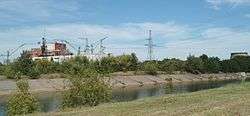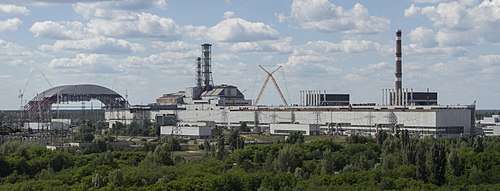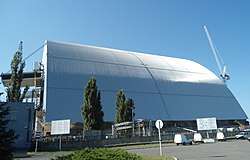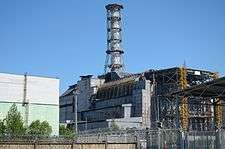Chernobyl Nuclear Power Plant
| Chernobyl Nuclear Power Plant | |
|---|---|
.jpg) The power plant with sarcophagus, in 2007 | |
| Country | Ukraine |
| Location | Pripyat |
| Coordinates | 51°23′23.47″N 30°5′38.57″E / 51.3898528°N 30.0940472°ECoordinates: 51°23′23.47″N 30°5′38.57″E / 51.3898528°N 30.0940472°E |
| Status | Decommissioned |
| Construction began | 15 August 1972 |
| Commission date | 26 September 1977 |
| Decommission date | ongoing since 2000 |
| Owner(s) | Government of Ukraine |
| Operator(s) | State Agency of Ukraine of the Exclusion Zone |
| Nuclear power station | |
| Reactor type | RBMK-1000 |
| Power generation | |
| Units operational | 0 |
| Units decommissioned | 4 x 1,000 MW |
| Nameplate capacity | 4,000 MW |
| Annual net output | 0 GWh |
|
Website www www | |
Reactor status:
| |

The Chernobyl Nuclear Power Plant or Chernobyl Nuclear Power Station (Ukrainian: Чорнобильська атомна електростанція, Chornobyls'ka Atomna Elektrostantsiya, Russian: Чернобыльская АЭС, Chernobyl'skaya AES) is a decommissioned nuclear power station near the city of Pripyat, Ukraine, 14.5 km (9.0 mi) northwest of the city of Chernobyl, 16 km (9.9 mi) from the Belarus–Ukraine border, and about 110 km (68 mi) north of Kiev. Reactor No. 4 was the site of the Chernobyl disaster in 1986 and the power plant is now within a large restricted area known as the Chernobyl Exclusion Zone. Both the zone and the former power plant are administered by the State Agency of Ukraine of the Exclusion Zone (Ministry of Ecology and Natural Resources). All four reactors have been shut down.
The nuclear power plant site clean-up is scheduled for completion in 2065. On January 3, 2010, a Ukrainian law stipulating a programme toward this objective came into effect.[1]
Construction
The V.I. Lenin Nuclear Power Station (Russian: Чернобыльская АЭС им. В.И.Ленина) as it was known during the Soviet times, consisted of four reactors of type RBMK-1000, each capable of producing 1,000 megawatts (MW) of electric power (3.2 GW of thermal power), and the four together produced about 10% of Ukraine's electricity at the time of the disaster.[2]
The Chernobyl station is 18 km (11 mi) northwest of the city of Chernobyl, 16 km (9.9 mi) from the border of Ukraine and Belarus and about 100 km (62 mi) north of Kiev. Construction of the plant and the nearby city of Pripyat, Ukraine to house workers and their families began in 1970, with Reactor N. 1 commissioned in 1977. It was the third nuclear power station in the Soviet Union of the RBMK-type (after Leningrad and Kursk), and the first nuclear power plant on Ukrainian soil.
The completion of the first reactor in 1977 was followed by reactor N. 2 (1978), N. 3 (1981), and N. 4 (1983). Two more blocks, numbered 5 and 6, of more or less the same reactor design, were planned at a site roughly 1 kilometre's distance from the contiguous buildings of the four older blocks. Reactor N. 5 was around 70% complete at the time of block 4's explosion and was scheduled to come online approximately six months later, on 7 November 1986. In the aftermath of the disaster, the construction on N. 5 and N. 6 were suspended, and eventually cancelled in April 1989, just days before the third anniversary of the 1986 explosion.[3] Reactor numbers’ 3 and 4 were second generation units, whereas numbers’ 1 and 2 were first-generation units (like those in operation at Kursk Nuclear Power Plant). Second-generation RBMK designs were fitted with a more secure containment structure visible in photos of the facility.[4]
Electrical systems
The power plant is connected to the 330 kV and 750 kV electrical grid. The block has two electrical generators connected to the 750 kV grid by a single generator transformer. The generators are connected to their common transformer by two switches in series. Between them, the unit transformers are connected to supply power to the power plant's own systems; each generator can therefore be connected to the unit transformer to power the plant, or to the unit transformer and the generator transformer to also feed power to the grid.[5]
The 330 kV line is normally not used, and serves as an external power supply, connected to a station's transformer - meaning to the power plant's electrical systems. The plant is powered by its own generators, or at an event gets power from the 750 kV national grid through the main grid backup feed in transformer, or from the 330 kV level feed in grid transformer 2, or from the other power plant blocks via two reserve busbars. In case of total external power loss, the essential systems can be powered by diesel generators. Each unit's transformer is therefore connected to two 6 kV main powerline switchboards, A and B (e.g. 7A, 7B, 8A, 8B for generators 7 and 8), powering principal essential systems and connected to even another transformers at voltage 4 kV which is backed up twice (4 kV reserve busbar).[5]
The 7A, 7B, and 8B boards are also connected to the three essential power lines (for the coolant pumps), each also having its own diesel generator. In case of a coolant circuit failure with simultaneous loss of external power, the essential power can be supplied by the spinning down turbogenerators for about 45–50 seconds, during which time the diesel generators should start up. The generators are started automatically within 15 seconds at loss of off-site power.[5]
Turbo generators
The electrical energy is generated by a pair of 500 MW hydrogen-cooled turbo generators. These are located in the 600 m (1,969 ft)-long machine hall, adjacent to the reactor building. The turbines—the venerable five-cylinder K-500-65/3000—are supplied by the Kharkiv turbine plant; the electrical generators are the TBB-500. The turbine and the generator rotors are mounted on the same shaft; the combined weight of the rotors is almost 200 t (220 short tons) and their speed is 3000 rpm.[6]
The turbo generator is 39 m (128 ft) long and its total weight is 1,200 t (1,300 short tons). The coolant flow for each turbine is 82,880 t/h. The generator produces 20 kV 50 Hz AC power. The generator's stator is cooled by water while its rotor is cooled by hydrogen. The hydrogen for the generators is manufactured on-site by electrolysis.[6] The design and reliability of the turbines earned them the State Prize of Ukraine for 1979.
The Kharkiv turbine plant (now Turboatom) later developed a new version of the turbine, K-500-65/3000-2, in an attempt to reduce use of valuable metal. The Chernobyl plant was equipped with both types of turbines; Block 4 had the newer ones. The newer turbines, however, turned out to be more sensitive to their operating parameters, and their bearings had frequent problems with vibrations.[7]
Reactor fleet

Four RBMK reactors were at Chernobyl Nuclear Power Plant, Ns. 1–4. The construction of two partially completed reactors, numbers 5 and 6, was suspended immediately after the accident at reactor N. 4, and was eventually cancelled in 1989.[8] Reactors 1-3 continued to operate after the disaster. Reactor N. 2 was permanently shut down in 1991 after a fire broke out due to a faulty switch in a turbine.
Reactors 1 and 3 were eventually closed due to an agreement Ukraine made with the EU in 1995. Ukraine agreed to close the remaining units in exchange for EU assistance in modernizing the shelter over reactor N. 4 and improving the energy sector of the country, including the completion of two new nuclear reactors, Khmelnitski 2 and Rovno 4. Reactor N. 1 was shut down in 1996 with N. 3 following in 2000.[9]
Accidents and incidents
1982: Reactor N. 1 partial meltdown
On September 9, 1982, a partial core meltdown occurred in Reactor N. 1 at the Chernobyl plant. The extent of the damage was minor, but the accident was not made public until several years later. The reactor was repaired and put back into operation within a few months.[10][11]
1986: Reactor N. 4 disaster
.jpg)
On Saturday, April 26, 1986, a disaster occurred at Reactor N. 4, caused by a catastrophic power increase resulting in core explosions and open-air fires. This caused large quantities of radioactive materials and airborne isotopes to disperse in the atmosphere and surrounding land. The disaster has been widely regarded as the worst accident in the history of nuclear power in the world. As a result Reactor N. 4 was completely destroyed, and therefore enclosed in a concrete and lead sarcophagus, followed more recently by a large steel confinement shelter, to prevent further escape of radioactivity. Large areas of Europe were affected by the accident. The radioactive cloud spread as far away as Norway.[12]
1991: Reactor N. 2 fire
The Chernobyl Nuclear Plant utilized one large, open turbine hall for all four reactors without any separating walls. Each reactor had two turbines. On October 11, 1991, a fire broke out in the turbine hall of Reactor number 2.[13] The fire began in Reactor number 2's Turbine 4 (ТГ-4 in Russian) while the turbine was being idled for repairs. A faulty switch caused a surge of current to the turbine, igniting insulating material on some electrical wiring.[14] This subsequently led to hydrogen, used as a turbine coolant, being leaked into the turbine hall "which apparently created the conditions for fire to start in the roof and for one of the trusses supporting the roof to collapse."[15] The adjacent reactor hall and reactor were unaffected.
2013 collapse

On February 13, 2013, a 600-square-metre (6,500-square-foot) portion of the roof and wall adjacent to the covered part of the turbine hall collapsed into the entombed area of the turbine hall. The collapse did not affect any other part of the Object Shelter or the New Safe Confinement. No variances in radiation levels as a result of the incident were detected.[16] The roof which collapsed was built after the Chernobyl disaster. It was later repaired.[17]
2017 cyber attack
On June 17, 2017, a cyberattack affected the radiation monitoring system and took down the power plant's official website which hosts information about the incident and the area.[18]
Plant shutdown and decommissioning
After the explosion at Reactor N. 4, the remaining three reactors at the power plant continued to operate. The schedule for plant decommissioning is intimately wrapped with the dismantling of Reactor N. 4 and the decontamination of its environs. The Chernobyl New Safe Confinement will have equipment which will make decommissioning relatively incidental to, yet an integral part of, the cleanup of the exploded reactor. The majority of the external gamma radiation emissions at the site are from the isotope caesium-137, which has a half-life of 30.17 years. As of 2016, the radiation exposure from that radionuclide has declined by half since the 1986 accident.
Reactor N. 1
In November 1996, following pressure from international governments, Reactor N. 1 was shut down.[19] Removal of uncontaminated equipment has begun at Reactor N. 1 and this work could be complete by 2020–2022.[20]
Reactor N. 2
In October 1991, Reactor N. 2 caught fire, and was subsequently shut down.[21] Ukraine's 1991 independence from the Soviet Union generated further discussion on the Chernobyl topic, because the Rada, Ukraine's new parliament, was composed largely of young reformers. Discussions about the future of nuclear energy in Ukraine ultimately moved the government toward a decision to cancel the operation of Reactor N. 2. In the mid-1990s, there were plans to restart reactor N. 2[22][23][24] but they were never carried out and the reactor remained shut down.
Reactor N. 3
In December 2000, Reactor N. 3 was shut down, and the plant as a whole ceased producing electricity.[19] On April 9, 2015, units 1–3 entered the decommissioning phase.[25]
Reactor N. 4 sarcophagus replacement

Originally announced in June 2003, a new steel containment structure named the New Safe Confinement would be built to replace the aging and hastily built sarcophagus that protected Reactor N. 4.[26] Though the project's development has been delayed several times, construction officially began in September 2010.[27] The New Safe Confinement was financed by an international fund[28] managed by the European Bank for Reconstruction and Development (EBRD) and was designed and built by the French-led consortium Novarka.[28] Novarka is building a giant arch-shaped structure out of steel, 270 m (886 ft) wide, 100 m (328 ft) high and 150 m (492 ft) long to cover the old crumbling concrete dome that is currently in use.[19]
This steel casing project is expected to cost $1.4 billion, and is expected to be completed by 2017. The casing will also meet the definition of a nuclear entombment device.[29] A separate deal has been made with the American firm Holtec to build a storage facility within the exclusion zone for nuclear waste produced by Chernobyl.[30][31][32]
On 14 November 2016, the arch began its expected five-day placement over the existing sarcophagus.[33] However, it ended up taking fifteen days. It was completed on 29 November 2016.[34]
Solar station
On 5 October 2018, a one-megawatt solar power plant began operation at the Chernobyl site. The plant is run by Solar Chernobyl LLC, a Ukrainian-German joint venture backed by RODINA Energy Group and Enerparc AG.[35][36]
General directors
- 1970–1986 Viktor Bryukhanov
- 1986–1987 Erik Pozdyshev
- 1987–1992 Mykhailo Umanets
- 1994–1998 Serhiy Parashyn
- 2004–2005 Oleksandr Smyshliayev
- 2005–present Igor Gramotkin
See also
Chernobyl articles:
- Chernobyl compared to other radioactivity releases
- Chernobyl disaster
- Chernobyl disaster effects
- Chernobyl Heart
- Cultural impact of the Chernobyl disaster
- List of Chernobyl-related articles
- List of Chernobyl-related charities
- Zone of alienation
Other accidents:
Nuclear safety:
- International Nuclear Event Scale
- Loss-of-coolant accident
- Nuclear meltdown
- Radioactive contamination
General:
References
- ↑ "Chernobyl nuclear power plant site to be cleared by 2065". Kyiv Post. 3 January 2010. Archived from the original on October 5, 2012.
- ↑ library.thinkquest.org Archived May 4, 2009, at the Wayback Machine. – All four of the reactors at the Chernobyl nuclear power station were of the RBMK-type
- ↑ "Soviets Cancel Plans for 2 New Reactors at Chernobyl". Los Angeles Times. 21 April 1989.
- ↑ "Early Soviet Reactors and EU Accession". Retrieved March 10, 2016.
- 1 2 3 British Nuclear Energy Society (1987). Chernobyl: a technical appraisal: proceedings of the seminar organized by the British Nuclear Energy Society held in London on 3 October 1986. London: Thomas Telford Ltd. ISBN 978-0-7277-0394-1. Retrieved June 27, 2010.
- 1 2 "Energoatom Concern OJSC Smolensk NPP About the Plant Generation" (in Russian). Snpp.rosenergoatom.ru. April 30, 2008. Retrieved March 22, 2010.
- ↑ "Последняя командировка - Архив - Forum on pripyat.com". Forum.pripyat.com. Retrieved March 22, 2010.
- ↑ International, From United Press (April 20, 1989). "Soviets Cancel New Reactors for Chernobyl". Retrieved April 1, 2018 – via LA Times.
- ↑ "Early Soviet Reactors and EU Accession - World Nuclear Association". www.world-nuclear.org. Retrieved April 1, 2018.
- ↑ "Archived copy". Archived from the original on October 18, 2014. Retrieved October 13, 2014. "З архівів ВУЧК-ГПУ-НКВД-КГБ" No. 1 (16) 2001 Чорнобильська трагедія в документах та матеріалах
- ↑ http://www.rri.kyoto-u.ac.jp/NSRG/reports/kr139/pdf/tykhyy-2.pdf pp. 252-263
- ↑ Medvedev, Zhores A. (1990). The Legacy of Chernobyl (Paperback. First American edition published in 1990 ed.). W. W. Norton & Company. ISBN 978-0-393-30814-3.
- ↑ "Fire Reported in Generator Area At the Chernobyl Nuclear Plant". The New York Times. October 12, 1991. Retrieved March 10, 2016.
- ↑ Roof fire at Chernobyl intensifies Ukrainian calls to close nuclear plant Baltimore Sun (October 13, 1991)
- ↑ Soviets Assure Safety at A-Plant Damaged by Fire New York Times (October 13, 1991)
- ↑ "Chernobyl radiation unaffected after heavy snow causes partial roof collapse, Ukrainian officials say". New York Daily press. Associated Press. February 13, 2013. Retrieved February 15, 2013.
- ↑ "Chernobyl roof collapses under snow". New Zealand Herald. AFP. February 14, 2013. Archived from the original on April 13, 2013. Retrieved February 15, 2013.
- ↑ "Chernobyl's radiation monitoring system has been hit by the worldwide cyber attack". independent.co.uk. June 27, 2017. Retrieved April 1, 2018.
- 1 2 3 Wil Mara (1 September 2010). The Chernobyl Disaster: Legacy and Impact on the Future of Nuclear Energy. Marshall Cavendish. pp. 96–. ISBN 978-0-7614-4984-3.
- ↑ "Decommissioning at Chernobyl". Archived from the original on February 2, 2009. Retrieved March 10, 2016.
- ↑ "Backgrounder on Chernobyl Nuclear Power Plant Accident". US Nuclear Regulatory Commission. Retrieved January 16, 2011.
- ↑ Educational Foundation for Nuclear Science, Inc. (July 1998). Bulletin of the Atomic Scientists. Educational Foundation for Nuclear Science, Inc. pp. 15–. ISSN 0096-3402.
- ↑ Robert E. Ebel (1994). Chernobyl and Its Aftermath: A Chronology of Events. CSIS. pp. 11–. ISBN 978-0-89206-302-4.
- ↑ Strategic Digest. Institute for Defence Studies and Analyses. January 1994.
- ↑ "Chernobyl 1-3 enter decommissioning phase". Retrieved March 10, 2016.
- ↑ Yasuo Onishi; Oleg V. Voitsekhovich; Mark J. Zheleznyak (3 June 2007). Chernobyl - What Have We Learned?: The Successes and Failures to Mitigate Water Contamination Over 20 Years. Springer Science & Business Media. pp. 247–. ISBN 978-1-4020-5349-8.
- ↑ Terra Pitta (5 August 2015). Catastrophe: A Guide to World's Worst Industrial Disasters. Vij Books India Pvt Ltd. pp. 64–. ISBN 978-93-85505-17-1.
- 1 2 Great Britain: Parliament: House of Commons: European Scrutiny Committee (1 March 2011). Nineteenth report of session 2010-11: documents considered by the Committee on 16 February 2011, including the following recommendations for debate, reviewing the working time directive; global navigation satellite system; control of the Commission's implementing powers; recognition and enforcement of judgments in civil and commercial matters, report, together with formal minutes. The Stationery Office. pp. 59–. ISBN 978-0-215-55666-0.
- ↑ "NOVARKA and Chernobyl Project Management Unit confirm cost and time schedule for Chernobyl New Safe Confinement". European Bank. April 8, 2011. Retrieved April 22, 2012.
- ↑ "Chernobyl 25". Archived from the original on March 10, 2013. Retrieved March 10, 2016.
- ↑ Holtec International Press Release (December 31, 2007)
- ↑ "New licence for Chernobyl used fuel facility". World Nuclear News. March 28, 2013. Retrieved April 2, 2013.
- ↑ https://www.bbc.co.uk/news/world-europe-37978482?SThisFB BBC news article
- ↑ "Unique engineering feat concluded as Chernobyl arch has reached resting place". www.ebrd.com. Retrieved April 1, 2018.
- ↑ https://www.reuters.com/article/us-ukraine-chernobyl-solar/three-decades-after-nuclear-disaster-chernobyl-goes-solar-idUSKCN1MF1UM
- ↑ https://phys.org/news/2018-10-chernobyl-life-solar-power.html
External links
| Wikimedia Commons has media related to Chernobyl Nuclear Power Plant. |
- Chernobyl Nuclear Power Plant – official website (in Ukrainian) English icon on home page
- Chernobyl Nuclear Power Plant at Google Maps
- Steel Sarcophagus Announcement.
- «Zone – virtual walk with comments» (in Russian) by Nataliya Monastirnaya
